For the volunteers, Wellesbourne Wings and Wheels on 16th June 2013 started at 6:30am. It wasn’t raining and the forecast was looking good! One of our main concerns in the run-up to the event had been the weather, another had been the serviceability of XM655.
The Vulcan was looking good, too, having performed perfectly in the practice engine run and taxi the previous day.
Most of us were on site and preparation for the day’s activities were well underway.
As the site was being set up, the classic cars started to arrive along with our traders and exhibitors.
This year we had extended the show from cars and military vehicles to include motorbikes and were allowing the general public to vote for their favourite, as well as vehicle owners themselves.
With well over 150 classic vehicles, it was a difficult choice to make!
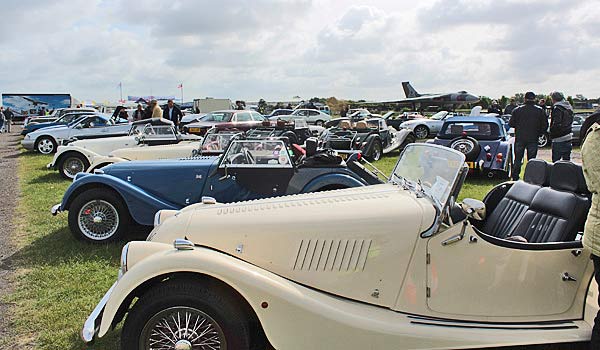
Copyright© Avril Magill
Over on the inactive runway, the Vulcan was towed into place ready to be the star of the day. Nearby we were very lucky to have the largest flying model aeroplane in the country (a Vulcan, of course!) being set up by Dave Johnson, Chairman of the Large Model Association, along with Tony Hooper’s large model Lancaster.
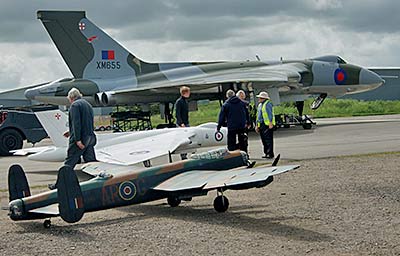
Copyright© Dougie Hales
Although the Lancaster did not fly during the day, it was wonderful to see models of both of Avro’s finest bombers parked together on display.
Next to the models we were also lucky to have a Bristol Hercules aero engine, brought to us by Brian Mills.

Slightly later than the other volunteers, the Vulcan crew for the day, Mike Pollitt, John Laycock, David Thomas and Barry Masefield, along with friends of XM655 Andrew Laycock and David McCulloch, settled into the cockpit and began the start up procedures.
Unfortunately at this point it all went wrong, an electrical fault causing the Vulcan to be shut down and the slow taxi run to be delayed.
XM655 is a fifty year old extremely complex military bomber, so these things happen! It is testament to the skill of the volunteers that the problem was cured within a couple of hours and that both the slow and fast taxi runs were able to happen with only the slight delay.
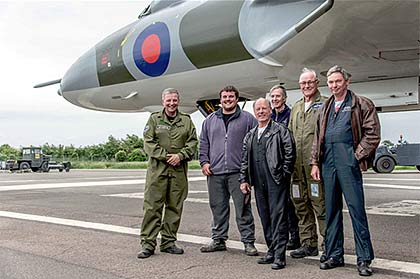
Throughout the day our commentator, Dave Rowland, kept the crowd informed about the changes to timings and the running order as well as entertaining them with his vast knowledge of all things aviation and interviews with a range of visitors, including Vulcan air crew.
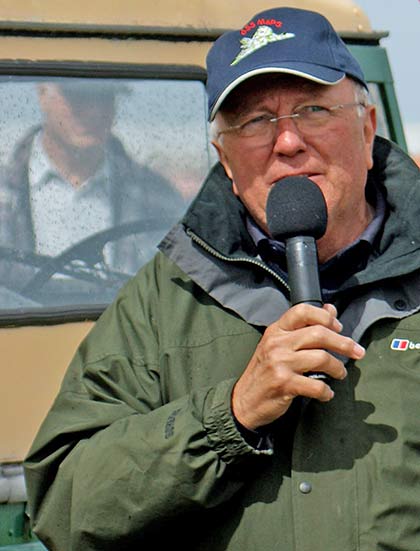
Copyright© Dougie Hales
While waiting for the Vulcan to taxi, there was an ideal opportunity for the model Vulcan, liveried as a 50 Squadron XH558 in anti-flash white, to fly its stunning 8 minute display, impressing everyone there – including those who have actually displayed the full scale XH558!
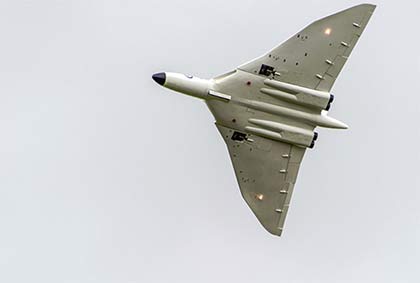
As the model was taxied back to its temporary pan next to XM655, Dave’s display was rewarded with a spontaneous, and well deserved, round of applause by the aircrew, ground crew and other MaPS officials who were standing in front of the Vulcan – it takes a lot to impress a bunch of hardened old timers like that!
We were also entertained by a couple of runs of the Hercules aero engine and, in the traders’ and exhibitors’ town square, the Perfect Vintage duo entertained the crowd with songs from the 1940s.

Copyright© Dougie Hales
Other stars in our town square were the Shackleton Preservation Trust’s Cockpit from Coventry, Hunter XE597 cockpit from Wolverhampton and a glider from the Stratford on Avon Gliding Club, all of which were open for people to have a look and a sit inside.
If you wanted to talk to experts about Vulcans, Avro test pilot, Tony Blackman, could be found in his gazebo chatting to people and selling copies of his books and another Vulcan author, Craig Bulman, was also promoting his new book, released by the Vulcan to The Sky Trust at Waddington, just three weeks later.
Craig also had lots of fascinating photos of Vulcans in service and, particularly, pictures of XM655. Those who visited him would have found out an interesting fact about a very famous Vulcan photo – all will be revealed in our Autumn MaPS newsletter. If you’re not a member of MaPS, join on-line now and receive the details of this and much more besides!
But, back to the real star of the day, XM655, all fixed and ready to roll for the slow taxi.
For this run, XM655 is taxied to the northern end of the runway, with plenty of opportunities for photos as it passes the crowd, then the engines are run up to about 85% before the brakes are released.
This is not enough to get the nose wheel off the ground but is quite dramatic, nonetheless!
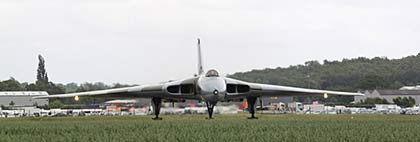
As XM655 taxied back to its position on the inactive runway it passed some of the static aircraft that had come to display at our event. This included Peter Teichman’s Hangar 11 Kittyhawk, which had just been repainted after starring in the movie Red Tails.
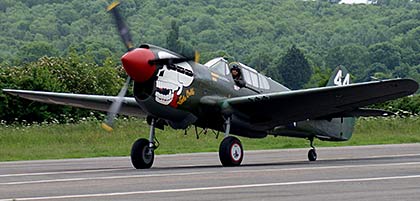
Copyright © Dougie Hales
Other visiting aircraft included a Chipmunk with a colour scheme from 1957 when it was the personal aircraft to the Air Commodore of the Metropolitan Sector, a Piper Cub and an Auster AOP6.
Earlier we had also had a Christen Eagle, which had departed leaving a trail of smoke across the airfield.

Between the two Vulcan runs we had an ideal opportunity to present the annual 655 Maintenance and Preservation Society Award to the Best Air Cadet from 150 (City of Oxford) Sqn. We have great support from both the staff and cadets of 150, who come up to Wellesbourne once a month to help us with a range of jobs and get their hands dirty (quite literally!) on a complex bomber and its ground equipment. This year the winner was Sgt Finlay Moncur, who had been runner up last year. The trophy was presented by Dave Rowland, who also presented the runner up prize to Cpl Richelle Bartlett. Both Finlay and Richelle are well known to all regular XM655 volunteers and we are delighted that their hard work throughout the year has been rewarded in this way.
This was also a good time to judge the classic vehicles, draw the raffle and announce the winners of the silent auction. The winning classic car (and there were lots to choose from!), and overall show winner, was a 1983 Tickford Capri owned by Les Mather who had travelled all the way down from Chesterfield. Second and third places went to an MGTF 1500 owned by Mr L Deykin and John Pugh’s Triumph Spitfire Mk 4.
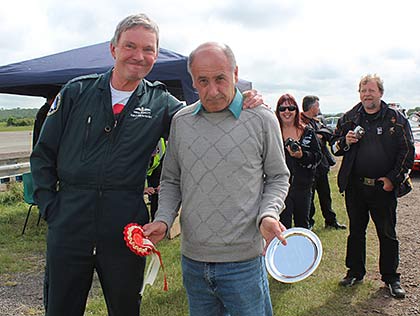
The winning motorbikes were a 1955 BSA 650cc owned by Anthony Jones from Solihull, a 1952 BSA Gold Star owned by Martin Smith and Mr G. W. Price’s 1955 Francis Barnett. We also awarded the top three places in our military vehicles category to Mr N Sawyer’s 1952 Land Rover, Brian Henson’s Dodge WC52 and John Hayley’s Land Rover Discovery.

Perfectly timed, after the departure of the Kitty Hawk, we had a visit from the Battle of Britain Memorial Flight Dakota, en route from Holland back to its home base at Coningsby. The Dakota performed three passes, before departing with a wing waggle.
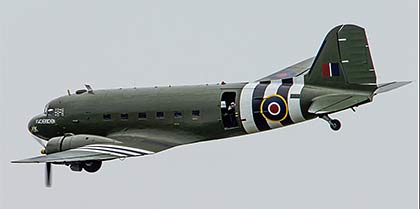
Finally, it was time for the big event of the day, the fast taxi of Vulcan XM655! Due to the speed the Vulcan attains during this run and the likelihood that the nose wheel will be lifted off the ground, the direction of this taxi run is wind dependant.
This year this meant starting at the northern end of the runway again. As this is very near the road, and each one of the Vulcan’s four Olympus 301 engines is capable of putting out 20,000lbs of static thrust, we had a team of people to close the road briefly, just to ensure that no high sided vehicles were accidentally caught in the efflux!
The power of this efflux was demonstrated well enough by some loose tarmac at the end of the runway which was kicked up by No.4 engine as it was being spooled up ready to go! The crew then released the brakes and the Vulcan sped down the runway, the power being quickly reduced, the airbrakes deployed to the high drag setting and the nose lifted, showing off the delta wings and also using them for aerodynamic braking.
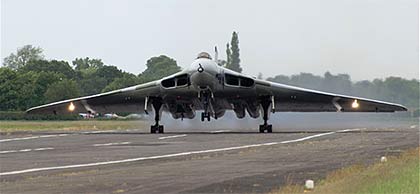
Once the nose wheel was back on the ground the wheel brakes were applied and the Vulcan brought to rest, all within the limitations of the 3,000ft runway we have at our disposal. The eagle-eyed amongst our spectators will have noticed that the pilots activated the brake parachute release (just as they would if they were landing on a short runway) but instead of a 25ft. diameter silk parachute appearing from the rear of the aircraft, an RAF ensign appeared instead! Another very successful run by our highly skilled crew. XM655 was then taxied back into position on the inactive runway.
Our regular fire cover provided by Warwickshire Fire & Rescue Service (Wellesbourne) was supplemented this year by retired fire tenders from Paul Brooks (ex-Birmingham Airport tender) and Tate Middleton (ex-Ronaldsway I.O.M. airport tender).
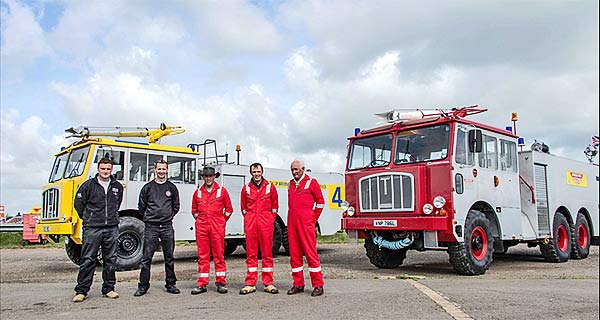
It is traditional that, once the taxi runs have been completed and it is safe to do so, the public are allowed under the Vulcan to see the star of the show close up.

This year, we had a full bomb carrier mounted centrally in the bomb bay carrying seven 1,000lb high explosive bombs, a third of the load delivered to the Falklands during the Black Buck raids. Although ours are inert and, being made of fibre glass, weigh nothing like 1,000lbs, it is an impressive sight and a reminder of the Vulcan’s role as a bomber during its service life.
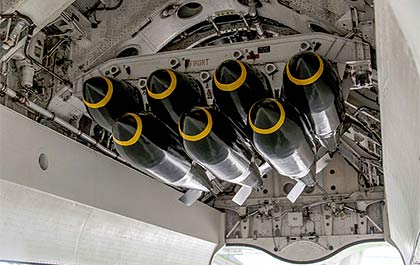
Although sleek and agile in the air, which is what makes it such a great display aircraft, the Vulcan’s real role was as a Cold War warrior and it was well named after the God of Fire!
All photos except where credited are Copyright © Clive Hanley
